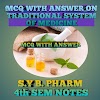AIM: To study capsule staining technique.
REFERENCE: -
1. Experimental Microbiology book (As Per PCI Syllabus) by Savita
Mandan, Umesh Laddha, Sanjay Surana, Published by Career Publication, First
edition, Page No 51 - 52.
2. Pharmaceutical Microbiology (As Per PCI Regulation) by Prof
Chandrakant Kokare, Published by Nirali Prakashan, First Edition, Page No. 6.3
– 6.6.
REQUIREMENTS:
CULTURES: Bacterial
Culture: 24 hours truth Bacterial culture.
STAIN: Crystal
violet, Nigrosin.
APPARATUS: Staining tray, glass slides, Bunsen burner,
inoculating loop, glass slide.
EQUIPMENT’S: Microscope.
INTRODUCTION: Capsule
is gelatinous outer layer secreted by microorganism which surrounds to the cell
wall. It is made up from polysaccharide and some are made up from peptidoglycan.
The main purpose of capsule stain is to distinguish capsular material from the
bacterial cell. Bacteria are classified into two types depending on the
presence or absence of capsule:
i)
Capsulated bacteria which possess capsule.
ii)
Non capsulated bacteria which do not possess
capsule.
PRINCIPLE: Capsules are fragile and can be
diminished or destroyed by heating. So drop of serum can be used during
smearing to enhance the size of capsule and easily observed by dyes like
crystal violet or methylene blue. In this staining like a background staining,
capsule remains unstained while the background is stained by either Nigrosin or
India ink.
PROCEDURE:
1.
The slide is cleaned properly under tap water.
2.
Wipe out adhering water from slide surface and
air-dry the slide.
3.
A smear of bacteria is prepared at the center of
marking area on glass slide.
4.
The smear is air dried, heat fixation is not
necessary. Heat treatment may result into cell shrinkage and hence capsular
damage. .
5.
The smear is then flooded with primary stain
crystal violet for 5-7 minutes.
6.
Wash the smear with 20% copper sulphate
solution.
7.
The slide is blotted dry with filter paper.
8.
Observe the smear under low power and then high
power objective.
OBSERVATION AND
RESULT: Capsule appears colorless
which surrounds the red cells against dark background while non-capsulated
bacteria which appear dark purple or blue.













0 Comments
Please do not enter any spam link in the comment box.